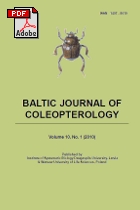Ground beetle community responses to heavy metal contamination
Main Article Content
Keywords
:
Carabidae, community structure responses, heavy metals, chronic pollution
Abstract
The effects of chronic heavy metal contamination on ground beetle community structure were investigated at five sites located along a pollution gradient caused by zinc-and-lead industry in southern Poland. Concentrations of Zn, the main pollutant, in humus layer along the gradient ranged from ca. 150 mg kg<sup>-1</sup> at the reference site (32 km from the pollution source) to 10500 mg kg<sup>-1</sup> at the most polluted site. The general species composition, as analyzed by Principal Components Analysis, did not show clear differences between sites that may be linked directly to the pollution level. Instead, soil habitat moisture was found as an important factor for species composition. However, species abundance and richness decreased significantly with increasing pollution level. Although species diversity (McIntosh index) also generally decreased with increasing metal concentration, the trend was not clear compared with the trends for abundance and richness. We hypothesize that this may be caused by sitespecific interspecies competition and niche overlap. Autumn-breeders appeared more sensitive to pollution compared with spring-breeders. We assume that this may be caused by differences in life-history patterns, with spring-breeders characterized by short larval stage and a relatively long adult life throughout the growing season that is more resistant to metal pollution.
Article Details
Statistics
Downloads
Download data is not yet available.
Recommend Articles
